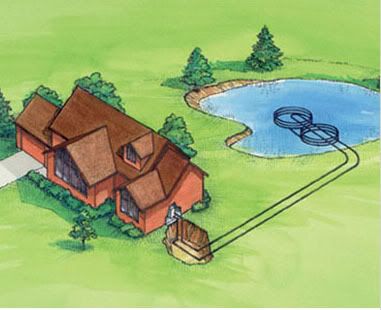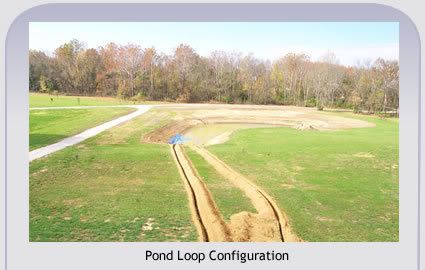I do not own a stretch of river, but a pond can likewise produce significant savings in electricity. Here is how it works: traditional heat pumps and central air-conditioners work on the principle of heat exchange. In the case of a heat pump, heat is extracted (exchanged) and delivered inside the house--even from cold winter air. With an a/c unit, heat (and humidity) are extracted and deposited outside, allowing a cooler and dryer air to be distributed inside the house. The two systems operate nearly identically; just in reverse application.
Anyone who pays heating and a/c bills knows that a good amount of electricity is required in order to accomplish this heat exchange. Fortunately, it is right at this point where a pond can be of significant benefit. In most regions, at depths of 10'+ deep a pond's water remains warmer than the coldest freezing winter temperatures above, and cooler than the warmest summer temperatures above. In other words, the pond's water itself becomes the source for heat exchange--providing warmth in the winter and cooling in the summer.
The process is really pretty straightforward as seen in this pic (found at http://www.waterfurnace.com/):

In the summer, the coils circulate warm fluid (typically a form of anti-freeze) from the house to the pond, which is cooled by the pond's lower temperature. This cooler fluid is then circulated back and, through an air blower, is distributes as lower air temperature throughout the house (i.e., central air-conditioning). The opposite exchange occurs during the winter. This is precisely the same principle for how standard electric heat pumps and air-conditioners operate. However, rather than consuming electricity to affect the transfer, the pond water temperature becomes the medium.
Here is a pic of destination and return trenches for one of these systems going to a pond (as found at http://geothermaldiy.com/gallery.html):

In short, in a year or two (God-willing) when I turn my attention to major changes to the house, this heating and air solution will be at the top of my list to install.
3 comments:
Do you think you might get into solar heating in the future, as well?
Mom V
I don't think so. For solar or wind resources to pay back their investment and consistently save money, the region has to be predominated by either sunlight or wind. Bother are obviously here, but neither predominate.
Its Great post! I like the details very much. It is very nice idea to have the use of pond for home purpose.
Post a Comment